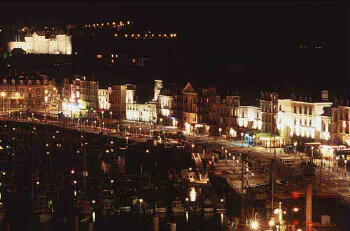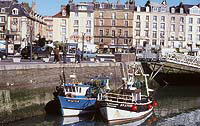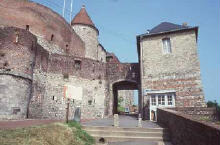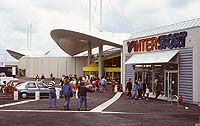
 Dieppe
Dieppe

THE FISHING PORT
DIEPPE is renowned for the scallops, herring, squid and sole that are brought in by its fishing fleet.
And the local-caught fish is on sale each morning from the trestle stalls that are set up by Jeanette Lainé and her friends outside the Tourist Information Office. The "End of the Quay" area contains the most ancient buildings in Dieppe: in the Place du Moulin à Vent, the rue des Cordiers and the rue des Veulets. These quaint streets behind the eastern end of the seafront have recently been renovated..
The "End of the Quay" area contains the most ancient buildings in Dieppe: in the Place du Moulin à Vent, the rue des Cordiers and the rue des Veulets. These quaint streets behind the eastern end of the seafront have recently been renovated..
Across the drawbridge from the quai Henri IV is Le Pollet where fishermen's families lived for centuries.There is a fine view over the port and the town from the top of the hill where the church of Notre Dame de Bon Secours watches over the sea and those who go to sea.
Reconstruction in 1435, the Castle already existed in the time of Roman Gaul. It has been a municipal property since the beginning of this century and became a museum in 1923. Its collection of sculptured ivories is world-renowned.
Dieppe has a long and chequered past, always linked with people and events from across the seas. The name of the town derives from "djupa", meaning "deep" in the language of the Vikings who found here the best place to land their boats. Dieppe was established as a harbour and by the 16th century it had grown into the principal port of the Kingdom of France.
 It was from here that Verrazano set sail in 1524 to found the settlement that later became New York City.
It was from here that Verrazano set sail in 1524 to found the settlement that later became New York City.
Relations between Normandy and Sussex have not always been as amicable as they are today: in 1525, a French fleet bombarded the fishing village of Brighthelmstone, now better known as Brighton. Then, three centuries ago, in 1694, an Anglo-Dutch fleet under the command of Admiral Berkeley bombarded Dieppe, setting most of it on fire.
Normany and Sussex are closely linked in the history of Europe.
Everybody knows about William the Conqueror, 1066 and all that. Fewer are acquainted with the story of the Huguenots – persecuted Protestant families of France who found refuge in England after the Revocation of the Edict of Nantes in 1685. Huguenot family names survive today on both sides of the Channel.
The First boats known to have come to Dieppe were those of the Vikings. But they did not bring holidaymakers. The regular passenger service, linking France with England, was established over 170 years ago. In June 1825, the General Steam Navigation Company advertised that its steamer, the Eclipse, would leave Newhaven for Dieppe, calling at Brighton Chain Pier, when weather and circumstances permitted, every Tuesday and Saturday, returning on Mondays and Thursdays. The ferry service got going in a serious way between Newhaven and Dieppe in 1847,and with a few hiccups is still running today.
The ferry service got going in a serious way between Newhaven and Dieppe in 1847,and with a few hiccups is still running today.
Many Brighton or Sussex people can "pop" over to Deippe for a days shopping at a reknown HYPERMARKET where you can buy bottles by the dozen and supplies enough to keep the family in provisions for weeks ahead.
 Return to the Fridge door
Return to the Fridge door